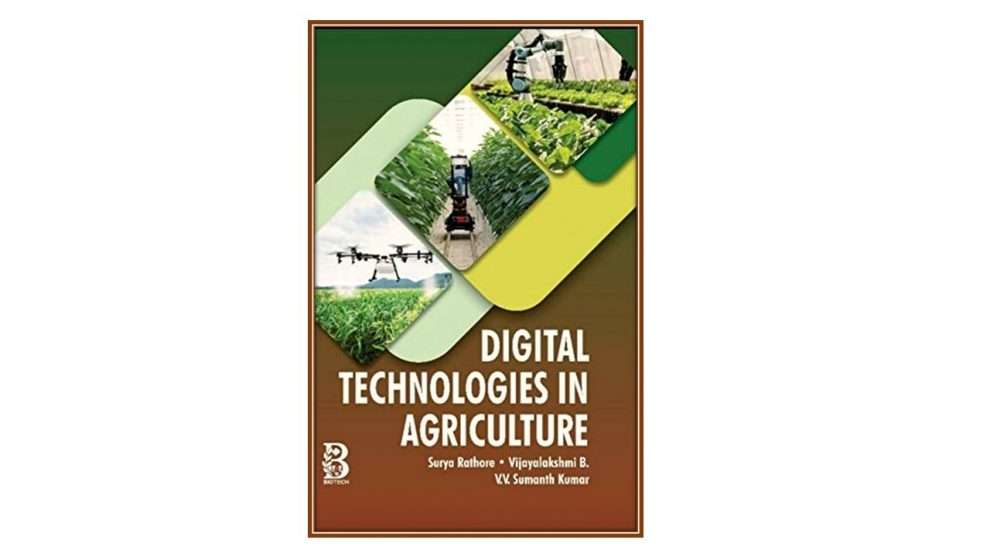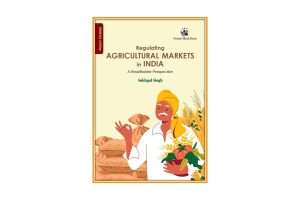Surya Rathore, Vijayalakshmi B, Sumanth Kumar VV (Eds.)
Biotech books, New Delhi
ISBN 978-81-7622-470-3
INR. 2,200 (Hardcover);
INR. 1,547 (Amazon, June 2021)
Pages: 254
The availability as well as factors that are necessary for crops, livestock, fisheries, agro-forestry and agro-processing. It is also important to address the need for demand driven and value-added information, which is time and location specific. Apart from information related to farming, farmers urgently need access to information about education, healthcare, government policies, product access to digital technologies is opening up new opportunities to integrate smallholder farmers and also to address and provide solutions to several challenges faced by them. Farmers need dynamic information on cultivation, management, meteorological, and marketing prices, market-led entrepreneurship opportunities, etc.
The adoption of new and advanced digital technologies offers the potential to deliver a steep change in productivity and/or profitability across the value chain by integrating farmers and other stakeholders. The book Digital Technologies in Agriculture provides an array of digital applications that are useful to address challenges in the farming community. Several ICT initiatives in the technology transfer system, such as internet, Kisan Call Centres, mobile phones, mass media, Common Service Centres which provides customized and updated information to the farmers, has been well-explained. In the present emerging information society, this book shares the use of community Radio, Television, mobile, eResources, GIS, remote sensing and Interactive Information Dissemination systems and their applications for knowledge dissemination in agriculture.
ICT-based advanced technologies such as Internet of Things (IoT) in agriculture, its applications and a few case studies in castor and groundnut has been highlighted. The need for digitisation to overcome the challenges of climate change in agriculture, GIS applications for decision making in agriculture, weed management, integrated dairy and farm management and precision farming involving the GIS technology – are all showcased in brief. In the era of mobile phones and internet, the chapters on mobile-based crop advisory app like Plantix, which uses Artificial Intelligence for tracking real time information on pests and diseases, weeds in the farmers’ fields; and use of drones for crop and livestock monitoring provides insights on the efforts being made to harness digital technologies in the service of the farming community.
Application of educational apps, cloud computing and MOOCs in agricultural education is a boon in today’s conditions. Their classification and use has been well explained in this book. The utility of social media platforms for knowledge dissemination in agriculture is also dealt with appropriately. The list of online tools for data collection and the steps for creating Google forms for conducting online survey has been well explained with pictorial representation for clear understanding and will be of utmost importance to the students and research scholars of Agriculture. The chapter on ‘Digital tools and their evaluation for impactful learning’ helps in understanding how to use appropriate digital tools in different technology/knowledge transfer contexts.
Digital technologies — including the Internet, mobile technologies and devices, data analytics, artificial intelligence, digitally-delivered services and apps — are changing agriculture and the overall food system. Examples abound at different stages in the agri-food value chain:
A. farm machinery automation allows fine-tuning of inputs and reduces demand for manual labour;
B. remote satellite data and in-situ sensors improve accuracy and reduce the cost of monitoring crop growth and quality of land or water; and
C. traceability technologies and digital logistics services offer the potential to streamline agri-food supply chains, while also providing trustworthy information to consumers.
The use of digital technologies has been gaining rapid momentum in the agricultural sector and since this has led to a lot of transformation in recent times, this book might have gained much by including a few chapters on recent innovative digital technologies.
Thus the book’s shortcoming is the lack of a few of the recent advances in the digitization context such as blockchain, machine learning, etc., and also the use of these technologies in overcoming the challenges in the agriculture sector, such as climate change, price fluctuations. There are many more applications such as digital technologies that can also help governments improve the efficiency and effectiveness of existing policies and programmes, and also design better ones. For instance, freely available and high-quality satellite imagery dramatically reduces the cost of monitoring many agricultural activities. This could allow governments to move towards more targeted policies which pay (or penalise) farmers based on observed environmental outcomes. In addition to monitoring compliance with environmental policies, digital technologies enable automation of administrative processes for agriculture and the development of expanded government services, such as in relation to extension or advisory services. All these could also have been included so as to provide a broader picture. Further there was no mention of agri tech start-ups that are spurring the use of digital technologies and revolutionizing the entire agriculture sector.
The chapter on ‘Conducting an online survey’ can definitely help students in carrying out the online survey for their research work during this pandemic situation. The readers can also focus on ‘AgMOOCs: An impressive digital approach in agricultural education’. As ICTs are playing a prominent role nowadays in agricultural education, knowledge of these online platforms for both teaching and learning would be very useful to the extension fraternity.
This publication has captured the experiences of various digital interventions such as web and mobile portals, GIS and remote sensing, IOT, drones, etc., in agriculture in a simple way rather than an exhaustive one. These experiences might help stakeholders to develop much more impactful innovations that may also digitalize the farming sector.
This book will be very useful to students and other stakeholders in gaining understanding and insights on some of the digital technologies that are being used in the agricultural sector.
Sai Sree G and Saravanan Raj
 Sai Sree G, Consultant, National Institute of Agricultural Extension Management (MANAGE), Hyderabad, India. She has a Masters in Agricultural Extension from Chandra Shekhar Azad University of Agriculture, Kanpur, U.P, India. You can reach her at (saisreegarlapati@gmail.com).
Sai Sree G, Consultant, National Institute of Agricultural Extension Management (MANAGE), Hyderabad, India. She has a Masters in Agricultural Extension from Chandra Shekhar Azad University of Agriculture, Kanpur, U.P, India. You can reach her at (saisreegarlapati@gmail.com).
 Dr Saravanan Raj, Director, National Institute of Agricultural Extension Management (MANAGE), Hyderabad, India. He did his PhD in Agricultural Extension at the University of Agricultural Sciences, Bengaluru. He joined MANAGE in 2016, working as Director (Agricultural Extension) and CEO for Centre for Innovation and Agripreneurship, MANAGE. He is a specialist in the areas of ICTs for agricultural extension, social media, extension reforms, privatization, institutional pluralism and innovations, and related policy issues. You can reach him at (saravanan.raj@manage.gov.in).
Dr Saravanan Raj, Director, National Institute of Agricultural Extension Management (MANAGE), Hyderabad, India. He did his PhD in Agricultural Extension at the University of Agricultural Sciences, Bengaluru. He joined MANAGE in 2016, working as Director (Agricultural Extension) and CEO for Centre for Innovation and Agripreneurship, MANAGE. He is a specialist in the areas of ICTs for agricultural extension, social media, extension reforms, privatization, institutional pluralism and innovations, and related policy issues. You can reach him at (saravanan.raj@manage.gov.in).





Add Comment